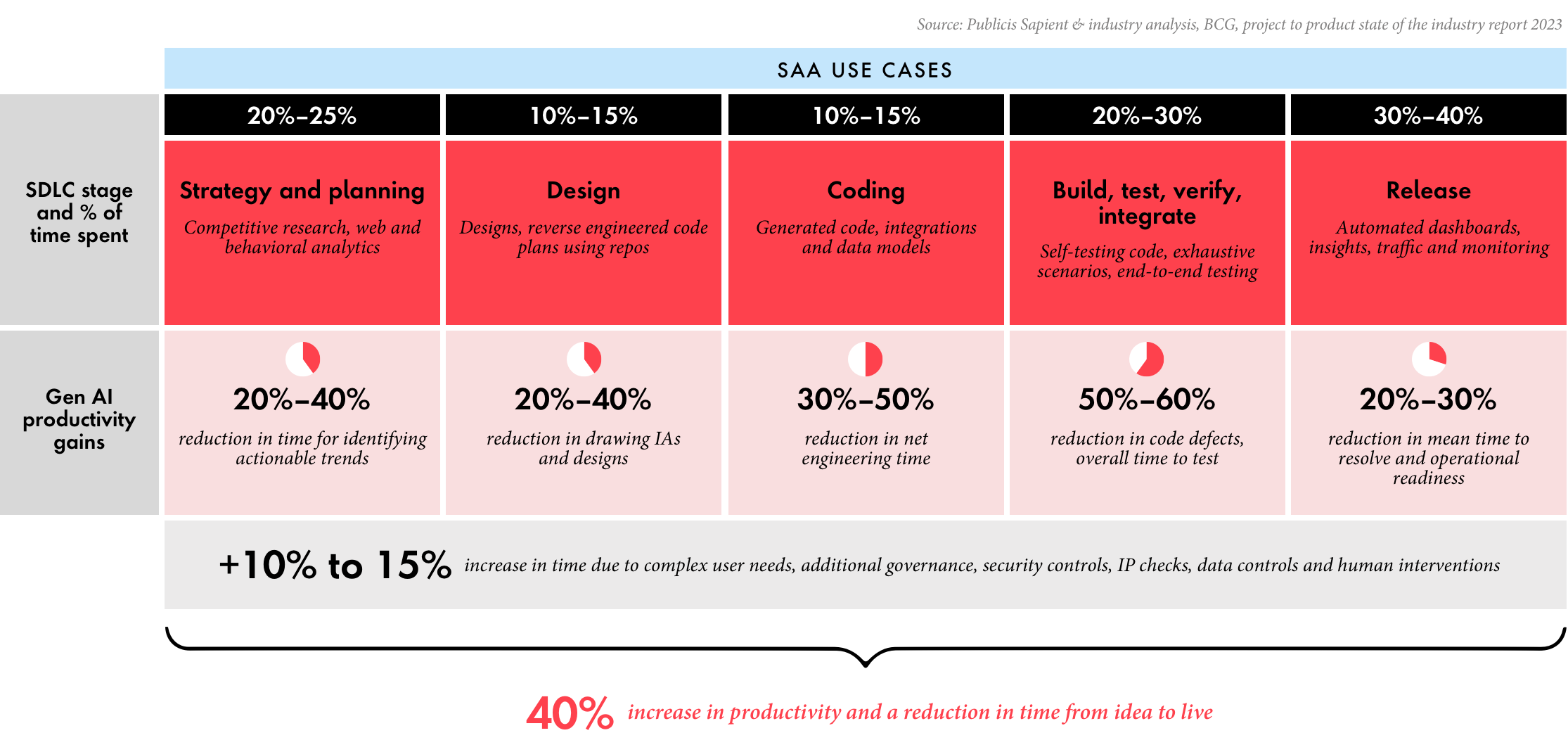What issue can we solve for you?
Type in your prompt above or try one of these suggestions
Suggested Prompt



Insight
Top Five Things CIOs Need to Know About AI-Driven Software Development
Top Five Things CIOs Need to Know About AI-Driven Software Development
Here’s what CIOs need to understand to navigate the software tsunami ahead.
AI is getting really good at writing code. Tools like GitHub Copilot have already helped millions of programmers, and some enterprises are already realizing the benefits of integrating AI into the software development lifecycle (SDLC). According to Publicis Sapient research, 47 percent of C-suite executives say increasing productivity is a top priority for AI transformation. However, only one in three CIOs report using generative AI models for use cases like code generation. The majority report they are still in the experimentation and exploration phase.
From our experience working on large-scale digital business transformation programs with our clients, along with our own $325 million investment in building our CoreAI platform for our parent company, Publicis Groupe, we’ve identified the five following success patterns for IT leadership to build a competitive advantage with AI in their SDLC.

Focus on the entire software development lifecycle, not just coding, to achieve up to a 40 percent increase in productivity.
Our benchmarks of implementing AI interventions across the SDLC in our client engagements reveal the potential to realize a 40 percent increase in productivity. Notably, less than half of the opportunity lies in coding, with massive opportunities in assisting strategists, designers, product and project managers, as well as DevOps specialists.

Our biggest insight is that sustainable gains in productivity, quality and business value are only realized when we systematize the use of AI interventions for specific business domains and development archetypes. By curating pre-training data (such as requirements documents, enterprise standards, architecture and code artifacts), investing in fine-tuning our models, updating prompt libraries and output templates and training our people to consistently apply the patterns applicable to the work type, we can pave the way for scaled, sustainable enterprise competency.

The biggest risk with the use of AI for software development is inadequate human skills.
In human pair programming, when a highly experienced developer is paired with a junior one, there's a risk of the "Watch the Master" phenomenon, where the junior developer becomes too passive. This phenomenon is especially applicable to AI-assisted software development. The humans who are guiding and inspecting the AI work require more expertise, not less, whether they are business strategists, product managers, experience designers, developers or data professionals. They must be curious, skilled at problem decomposition and experts at double-checking the AI's work so they can take responsibility for the AI's output and the solution's outcomes.
Humans must also focus on mitigating key risks in an AI-assisted SDLC by ensuring AI systems are transparent and explainable, securing data and thoughtfully selecting use cases.
It’s important to proactively establish robust workflows with human oversight and measure performance to optimize AI's benefits while mitigating potential harm.

The agile software development manifesto needs to evolve for the age of AI.
The 23-year-old Agile Manifesto must evolve to address the new opportunities and challenges posed by advanced AI-assisted software development. While the original manifesto emphasized human interactions, working software, customer collaboration and adapting to change, it now needs to include values that reflect the integration of AI tools and methods, the speed and efficiency these enable and the need to obsessively focus on business and customer value creation.

Boosting efficiency with AI will spur demand and require increased investment in digital transformation.
In the future, humans will continue to build more software. The Jevons paradox explains why this is inevitable. The paradox highlights the phenomenon where technological advancements that improve resource efficiency paradoxically result in increased resource consumption due to increased demand, rather than reduction. If the Jevons paradox applies to AI-enabled software development, as it has with countless other technologies, companies that redouble their investments in digital business transformation will have far better odds of maintaining and growing their competitive edge.
To build for the future, companies need to focus on skills, talent and organizational transformation. Professionals in strategy, product, experience, engineering and data should integrate AI into their work to become more efficient and effective. The challenge of creating unique value will shift from coding and production to how companies develop strategies, customer propositions and design specs.
Just as a chain is only as strong as its weakest link, the process will only be as fast as its slowest step. IT leaders need to completely rethink and improve the entire software development lifecycle, from initial ideas to final deployment.

Using proprietary data for custom AI model training provides a significant competitive edge over generic public models.
Enterprises possess unique corporate data and expertise that can be used to train customized models tailored to their specific needs, standards and IT foundations (e.g., enterprise APIs). Investing in data curation and fine-tuning custom models will significantly accelerate progress compared to using public models alone. Additionally, training employees to effectively prompt these tailored models can further enhance differentiation.
What is the role of the CIO in the age of AI?
As leaders, our task is to reimagine our capabilities, seamlessly integrate AI into our workflows and position our organizations to thrive in this evolving landscape. With a steadfast focus on skills development, organizational transformation and leveraging proprietary data, we can turn the immense potential of AI into reality.
Our opportunity is not just about reducing costs or replacing human effort. Instead, it's about unlocking unparalleled opportunities for growth and innovation throughout the software development lifecycle.
How Publicis Sapient can help
To maximize the potential of AI, businesses first need to embrace digital business transformation (DBT). At Publicis Sapient, we specialize in guiding companies through DBT, so that they can apply AI across all areas of their business.
Recognized as a 2023 Market Leader in Generative Enterprise Services by HFS Research, our teams use AI to transform business models, accelerate time to market and reimagine customer and employee experiences, among many other objectives of our clients’ DBT journeys.
Sapient Slingshot
Sapient Slingshot is our proprietary AI platform designed to accelerate software development across all stages of the software development lifecycle (SDLC). The platform supports code generation, testing, deployment and more, powered by agentic AI and an enterprise code library with industry context. When paired with our expert engineers, the platform delivers faster, higher-quality solutions.
AI application modernization
Leverage AI to transition your legacy systems to modern, scalable architectures. Using a blend of human expertise and AI-assisted collaboration, we accelerate code migration, streamline documentation and automate testing. This solution enables faster, more reliable transitions, and sets your business up for growth with a flexible and future-ready system.
AI custom application development
Develop custom applications with AI assistance every step of the way. Code, test and deploy at an accelerated rate, allowing you to focus on identifying and delivering the features your end users want.
AI MarTech transformation
Streamline your MarTech transformation by migrating your platforms, like Adobe Experience Manager, to the cloud with an AI-powered, agile approach. Seamlessly transition your code and configurations for enhanced performance and scalability.
AI test automation
Improve your testing speed, coverage and accuracy while reducing defects. We’ll create a modular testing framework that adapts to your quality and development engineering processes.
Related Reading
-
![]()
Sapient AI Solutions
Transform your business with tailored AI strategies designed to unlock unique value and drive digital innovation sustainably.
-
![]()
The Generative AI Risk Management Playbook
Most generative AI projects stall before launch. This guide reveals how to overcome common challenges and get your prototypes to production faster.
-
![]()
Digital Engineering Solutions
Innovate and refine your product engineering processes with tailored solutions incorporating generative AI-powered testing for outcome-based delivery.






